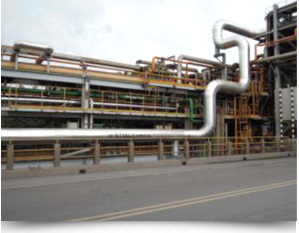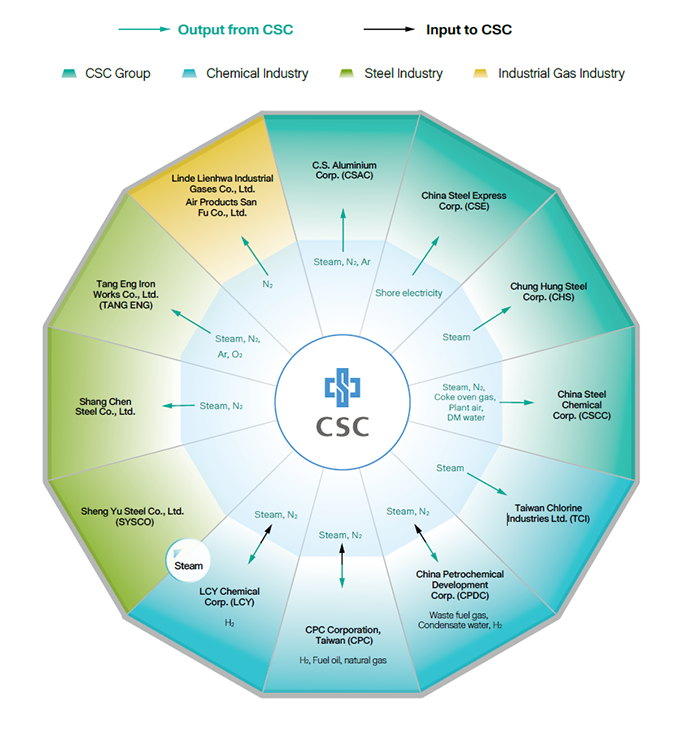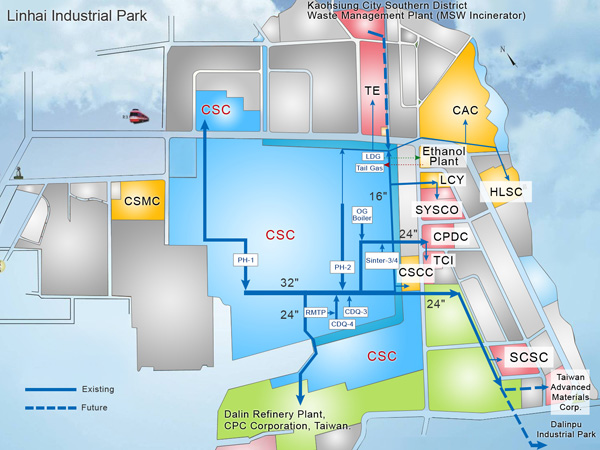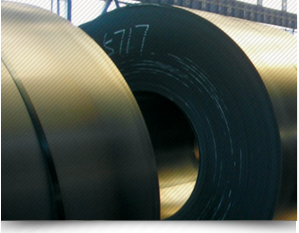

CSC is located in Kaohsiung LinHai Industrial Park, surrounded by a number of petrochemical and steel plants. CSC has long utilized steam produced from combined heat and power (CHP) and waste heat recovery as well as industrial gases produced from oxygen plant to share excess energy with neighboring plants. With the complementary uses of steam, oxygen, nitrogen, argon, plant air, coke oven gas, etc., energy and resources in the district is efficiently integrated. Users can turn off existing facilities with lower efficiency and higher GHG emissions or terminate new investments with lower efficiency and at same time achieve the objectives of improving energy utilization efficiency, reducing resource consumption, and lowering pollutant and GHG emissions to effectively mitigate environmental impact and improve environmental quality.
At present, a total of 14 manufacturers, including CSC, have joined the District Energy Integration. The energy that CSC sells include steam and oxygen, nitrogen and argon produced by the Oxygen Plant. Among them, steam is the main item. The amount of steam sold in 2022 was 1.480 million tonnes, saving 4.51 million GJ (equivalent to 114,000 kL of low-sulphur oil.) In terms of reducing GHG emissions and improving air pollution, it reduced 355,000 tCO2e of GHG, 1,082 tonnes of SOx, 750 tonnes of NOx, and 107 tonnes of particles(I)(II)(III), creating a multi-wins situation for CSC, customers, and the environment.


| Company | Output from CSC | Input to CSC |
|---|---|---|
| China Petrochemical Development Corp.(CPDC) | Steam, N2 | Waste fuel gas, Condensate water, H2 |
| CPC Corporation, Taiwan (CPC) | Steam, N2 | H2, Fuel oil, natural gas |
| C.S. Aluminum Crop.(CSAC) | Steam, N2, Ar | - |
| China Steel Express Corp.(CSE) | Shore electricity | - |
| Chung Hung Steel (CHS) | Steam | - |
| China Steel Chemical Corp. (CSCC) | Steam, N2, Coke oven gas, Plant air, DM water | - |
| Taiwan Chlorine Industries Ltd. (TCI) | Steam | - |
| Shang Chen Steel Co. | Steam, N2 | - |
| Tang Eng Iron Works (TANG ENG) | Steam, N2, Ar, O2 | - |
| Linde LienHwa Industrial Gases Corp. (LLH) | N2 | - |
| Air Products San Fu | N2 | - |
| LCY Chemical Corp. (LCY) | Steam (Part of steam is sold to Sheng Yu Steel Corp., SYSCO), N2 | H2 |
Unit:tCO2e
The Plan is implemented by CSC since 1992. Later that year, a drought struck Taiwan, the petrochemical factory of LCY Chemical Industry Corporation (LCY) faced severe shortage of steam. LCY even had to transport water from Dashu at 20 km away to avoid production halt. However, the threat of production halt still stood. LCY finally approached the adjacent CSC. Therefore, in the right place at the right time and with great endeavouring, CSC and LCY reached consensus on steam supply within three months.
Since the first steam supply to LCY in 1993, the Plan has attracted more participants in the Linhai Industrial Park, including China Petrochemical Development Corporation and CPC Corporation, Taiwan. However, the original design of the Park did not reserve for utility networks. Pipelines from CSC to these factories have to cross public roads and a 60 m-wide water channel with underground culverts and pipeline bridges, owned by different parties, to reach the destinations located 1 to 5 km away. A critical work for establishing distribution networks is therefore the construction of pipelines and the acquirement for the permissions of passing the roads. With the collaboration of public sectors, engineering units, contractors, and CSC, the 32 inch main steam pipeline in CSC and 6 to 24 inch distribution pipelines to the customers are installed. The length of steam pipelines measures at 20 km.

District Energy Integration – steam networks.
In addition to steam, industrial gases including O2, N2, and Ar are also important items in the Plan. The length of the industrial gas pipelines totals at 15 km. With the pipelines of customers, N2 can even be transported to another industrial park 20 km away.
The cumulative investment on distribution networks totals at more than USD 50 million.
A critical challenge besides infrastructure and pipeline networks is to attract new customers. CSC made considerable efforts communicating with potential customers regarding the exceptional quality, stability, and reliability of CSC’s by-product energy. For customers, the Plan assists in reducing cost in energy, land, and equipment, as well as lessening complications in safety and environment. Not only the competitiveness of customers is increased, their capability to adapt to climate change is also enhanced.
Given the remarkable performances of CSC, the Industrial Development Bureau of the Ministry of Economic Affairs (MOEAIDB) launched the “Industrial Park Energy and Resource Integration” plan for nation-wide eco-industry development.
District Energy Integration was easier said than done. Its benefits were evident on the economy, the environment, and the society. For implementation, however, complications and challenges arose with various liabilities and interests of all parties involved. It was only with years of communicating and engaging with governmental authorities and customers that CSC brought the Plan to success.
Major communications and outreaches are listed as follows.
 Helps MOEAIDB to launch the “Industrial Park Energy and Resource Integration” plan.
Helps MOEAIDB to launch the “Industrial Park Energy and Resource Integration” plan. Collaborates with public sectors, engineering units, and contractors for the planning and construction of pipeline networks.
Collaborates with public sectors, engineering units, and contractors for the planning and construction of pipeline networks. Hosts or assists meetings to communicate the benefits of District Energy Integration with the government, industries, the academia, and NGOs.
Hosts or assists meetings to communicate the benefits of District Energy Integration with the government, industries, the academia, and NGOs. Investigates the demands for steam and industrial gases in the industrial park for the most efficient match of utilization.
Investigates the demands for steam and industrial gases in the industrial park for the most efficient match of utilization. Negotiates and offers long-term, favorable contracts to individual customer.
Negotiates and offers long-term, favorable contracts to individual customer.
| No. | Company | Sold outside energy | Starting date | Remarks |
|---|---|---|---|---|
| 1 | China Steel Chemical Corp. | Coke Oven gas (COG), Steam, Plant Air, N2, Demineralized Water (DMW) | 1992.11 | CSC Group |
| 2 | LCY Chemical Corp. | Steam, N2 | 1993.12 | |
| 3 | CPC Corp. | N2, Steam | 1994.07 | |
| 4 | Tang Eng Iron Works Co., Ltd. | N2, O2, Argon, Steam | 1997.03 | |
| 5 | C.S. Aluminum Crop. | N2, Argon, Steam | 1998.07 | CSC Group |
| 6 | Linde LienHwa Crop. | N2 | 2000.03 | |
| 7 | China Petrochemical Development Corp. | Steam, N2 | 2002.07 | |
| 8 | Sheng Yu Steel Corp. | Steam | 2004.09 | |
| 9 | Taiwan Chlorine Industries | Steam | 2004.09 | |
| 10 | Air Products and Chemicals, Inc. | N2 | 2005.11 | |
| 11 | Shang Chen Steel | N2, Steam | 2010.09 | |
| 12 | China Steel Express Corp. | Shore Electricity | 2012.10 | CSC Group |
| 13 | Hung-Li Steel Corp. | Steam | 2013.07 | CSC Group |
The forthcoming energy shortage of the 21 century demands resource exploration and usage conservation. Through the District Energy Integration Plan, CSC transforms by-product fuel gases and waste heat to valuable resources and shares with other industries for efficient use. In addition to local benefits for the community, it provides a globally applicable solution to a sustainable future.
For the next step, CSC will support government policies to expand the success of energy integration by acquiring new customers, offering more utilities, and establishing extended networks. CSC expects to extend the coverage of integration to include the perspective Dalinpu Industrial Park. In addition to steam and industrial gases, CSC will develop high-value applications for other by-product energy. An on-going project is to extract CO from BOF gas and sell to petrochemical industry.
In line with the international practices, CSC will continue the endeavours in R&D and implementation of energy saving, emission reduction, waste minimization, and resourcilisation for sustainable development.

Net-zero carbon emission is currently a topic of great concern to the whole world. With the intention of achieving various goals such as advancing ESG and sustainable development efforts and realizing environmental management and clean production, CSC has set up the “Task Force on Energy Saving & Carbon Reduction and Carbon Neutrality” in February 2021 to formulate and promote carbon reduction initiatives in six areas, including energy efficiency enhancement, hydrogen-rich gas injection in blast furnaces, increased use of steel scrap, carbon capture, utilization, and storage (CCUS) via coproduction between steel and petrochemical plants, use of hot briquetted iron (HBI), and renewable energy. Coproduction between steel and petrochemical plants is an effective carbon reduction strategy that involves integrating resources from both the steel and petrochemical industries. While raw material costs in the petrochemical industry can be reduced by such a joint effort, this cross-industry collaboration model not only helps both industries reduce carbon emissions significantly, but can also expand CSC's scope of district energy resources, thereby becoming the best example in the practice of circular economy while progressing towards net zero carbon emissions.
By-product gases produced from steelmaking processes at CSC, such as blast furnace gas (BFG) and LD-converter gas (LDG), are rich in carbon monoxide (CO) and carbon dioxide (CO2). In the past, by-product gases were primarily supplied to reheating furnaces at factories for heating and boilers at power houses for gas-fired power generation. With the introduction of “coproduction between steel and petrochemical plants” as a new cross-industry collaboration model born out of previously established district energy integration and cooperation between CSC and petrochemical industry players in Linhai Industrial Park, both parties can not only share and exchange excess energy sources such as steam, nitrogen, and hydrogen with each other, but also expand the supply of carbon resources such as CO and CO2, which are raw materials used for synthesizing chemicals in the petrochemical industry, in the future. CO and CO2 extracted from the by-product gases provided by CSC can replace raw materials for petrochemicals that have to be imported by the petrochemical industry from abroad, and can be used to synthesize general-purpose chemicals such as methane, methanol and acetic acid through various processes in the petrochemical industry, thereby realizing the benefits of carbon fixation.

The “Coproduction between Steel and Petrochemical Plants” initiative launched by CSC and the petrochemical industry is divided into three stages. In Stage 1 - “Establishing laboratory and pilot plant technology,” carbon capture from by-product gases and high-value technologies are developed in collaboration with the Industrial Technology Research Institute (ITRI) and funded by the National Forward-looking Program, with site validation to be conducted as well. In Stage 2 - “Building a demonstration production line for coproduction between steel and petrochemical plants,” the first demonstration production line for coproduction between steel and petrochemical plants in Taiwan will be built, with the facility projected to reduce 240,000 tonnes in carbon emissions each year. Moreover, Stage 3 involves extending the initiative to “commercial use,” where it is projected to reduce 2.9 million tonnes in carbon emissions each year, equivalent to the CO2 uptake of 7,450 Da'an Forest Parks(I), thereby helping the petrochemical industry form a low-carbon chemical industry chain.
CSC and CPC Corporation signed a memorandum of understanding on August 27, 2021, with the construction of an R&D platform as the prelude to the initiation of cooperation. CSC is also in talks with other petrochemical companies such as Chang Chun Group, Dairen Chemical Corporation, CSCC, and UPC Technology Corporation over potential cooperation. CSC looks forward to seizing new business opportunities from carbon reduction through collaboration and progressing towards net zero carbon emissions together, thereby “contributing to environmental protection while generating benefits simultaneously” and turning the carbon reduction crisis into a turning point and a business opportunity. The pilot plant for co-production between steel and petrochemical plants was completed in September 2022. CSC collaborated with ITRI in conducting on-site verification of by-product gas carbon capture and high value utilization technologies.
Note: I. The annual carbon absorption of a Daan Forest Park is about 389 tonnes CO2e/year, which is based on the "2021 Solar Photovoltaic 6.5GW Standardization Plan of the Energy Bureau of the Ministry of Economic Affairs".